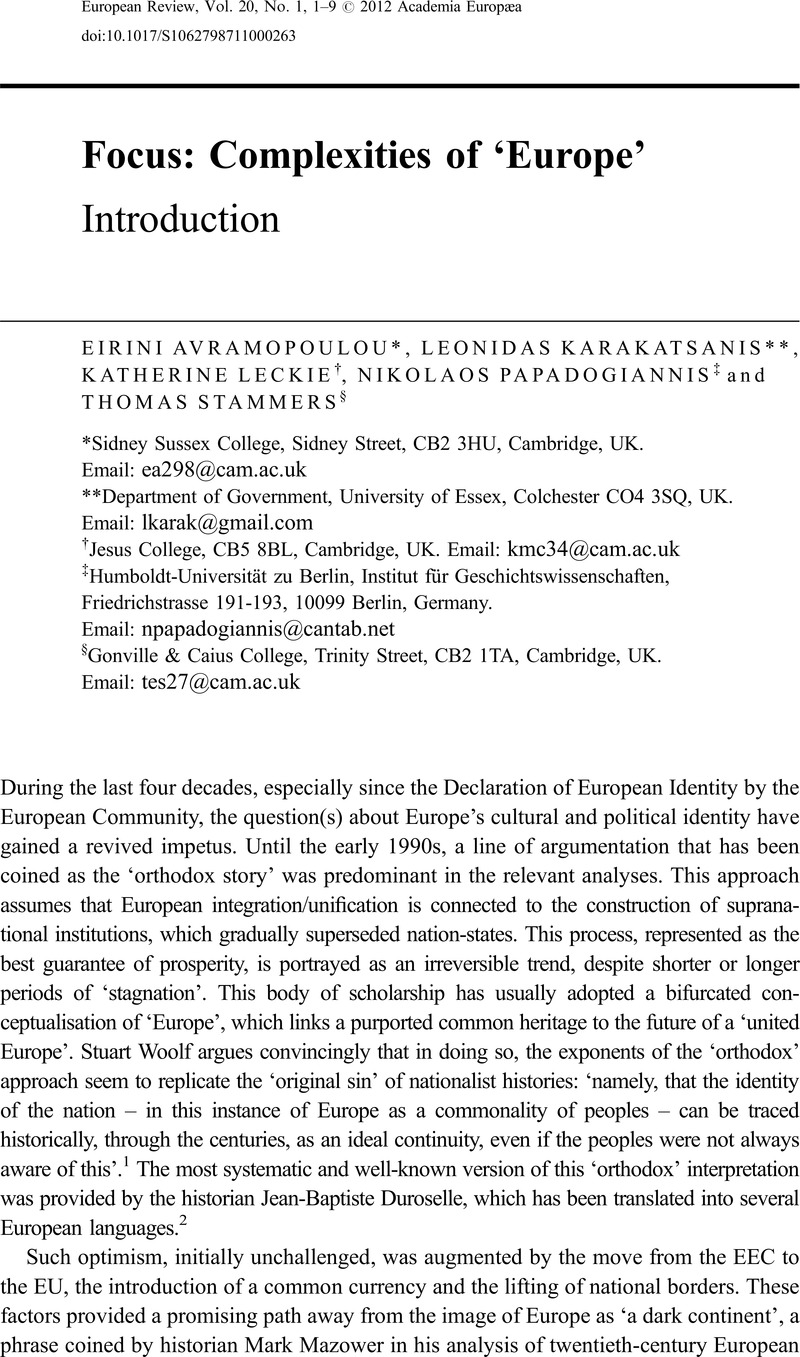No CrossRef data available.
Article contents
Introduction
Published online by Cambridge University Press: 04 January 2012
Abstract
An abstract is not available for this content so a preview has been provided. Please use the Get access link above for information on how to access this content.

- Type
- Focus: Complexities of ‘Europe’
- Information
- Copyright
- Copyright © Academia Europaea 2012
References
References and Notes
1.Woolf, S. (2003) Europe and its historians. Contemporary European History, 12(3), pp. 323–337.CrossRefGoogle Scholar
2.Duroselle, J.-B. (1990) Europe: a History of its Peoples (London, New York: Viking).Google Scholar
3.Mazower, M. (1999) Dark Continent: Europe's Twentieth Century (London: Penguin), p. 10.Google Scholar
4.Delanty, G. (1995) Inventing Europe: Idea, Identity, Reality (Houndmills, Basingstoke: Macmillan), p. 1.CrossRefGoogle Scholar
6.Gilbert, M. (2008) Narrating the process: questioning the progressive story of European integration. Journal of Common Market Studies, 46(3), pp. 641–662.CrossRefGoogle Scholar
7.Ash, T. G. (1996) Is Europe becoming Europe? Sanford S. Elberg Lecture in International Studies, Institute of International Studies, Berkeley, University of California, 3 April 1996. Available at: «http://globetrotter.berkeley.edu/Elberg/GartonAsh/ga-elb01.html» (last accessed 13 April 2010).Google Scholar
8. For a right-wing, Eurosceptic narrative, see Gillingham, J. (2003) European Integration 1950–2003 (Cambridge: Cambridge University Press).CrossRefGoogle Scholar
9.Chakrabarty, D. (2000) Provincializing Europe: Postcolonial Thought and Historical Difference (Princeton, NJ: Princeton University Press).Google Scholar
10.Stråth, B. (2000) Europe and the Other and Europe as the Other (Bruxelles; New York: P.I.E.-Peter Lang).CrossRefGoogle Scholar
12. See Pagden, A. (ed.) (2002) The Idea of Europe. From Antiquity to the European Union (Cambridge: Cambridge University Press and Woodrow Wilson Center Press).CrossRefGoogle Scholar
13. See Goddard, V., Llobera, J. R. and Shore, C. (eds) (1994) The Anthropology of Europe: Identity and Boundaries in Conflict (Oxford: Berg).Google Scholar
14.Delanty, G. (2003) The making of a post-Western Europe: a civilizational analysis. Thesis Eleven, 72.Google Scholar
15.Delanty, G. (2005) The idea of a cosmopolitan Europe. International Review of Sociology, 15(3).CrossRefGoogle Scholar
16.Delanty, G. and Rumford, C. (2005) Rethinking Europe: Social Theory and the Implications of Europeanization (London; New York: Routledge).CrossRefGoogle Scholar
17.Banchoff, T. and Smith, M. (1999) Legitimacy and the European Union the Contested Polity (London & New York: Routledge, 1999), http://site.ebrary.com/lib/princeton/Doc?id=10017618Google Scholar
18.Ash, T. G. (1994) In Europe's Name: Germany and the Divided Continent (New York: Vintage Books).Google Scholar
19.Milward, A. (2000) The European Rescue of the Nation-State, 2nd edn (London: Routledge).Google Scholar
20.Kaiser, W. (2007) Christian Democracy and the Origins of the European Union (Cambridge: Cambridge University Press).CrossRefGoogle Scholar
21.Modood, T. and Werbner, P. (1997) The Politics of Multiculturalism in the New Europe: Racism, Identity, and Community, Postcolonial Encounters (London; New York: Zed Books).Google Scholar
23.Boedeltje, F. and Houtum, H. V. (2008) The abduction of Europe: a plea for less unionism and more Europe. Tijdschrift voor Economische en Sociale Geografie (TESG), 99(3).Google Scholar
24.Houtum, H. V. and Pijpers, R. (2007) The European Union as a gated community: the two-faced border and immigration regime of the EU. Antipode, 39.Google Scholar
25.Shore, C. (2000) Building Europe: the Cultural Politics of European Integration (London; New York: Routledge).Google Scholar
26.Shore, C. (2007) European integration in anthropological perspective: studying the ‘culture’ of the EU civil service. In R. A. W. Rhodes, P. t’ Hart, and M. Noordegraaf (eds) Observing Government Elites: Up Close and Personal (Basingstoke: Palgrave MacMillan).Google Scholar
27.Balibar, E. (2003) Europe, an ‘unimagined’ frontier of democracy. Diacritics, 33(3/4).CrossRefGoogle Scholar
28.Balibar, E. (2003) We, the People of Europe? Reflections on Transnational Citizenship (Princeton: Princeton University Press).Google Scholar
29.Derrida, J. (1992) The Other Heading: Reflections on Today's Europe (Bloomington: Indiana University Press).Google Scholar
31.Stavrakakis, Y. (2004) Passions of identification: discourse, enjoyment and European identity. In D. Howarth and J. Torfing (eds) Discourse Theory in European Politics (Basingstoke: Palgrave Macmillan).Google Scholar
32.Passerini, L. (1999) Europe in Love: Love in Europe. Imagination and Politics between the Wars (New York; London: New York University Press).Google Scholar
35.Appadurai, A. (1986) The Social Life of Things: Commodities in Cultural Perspective (Cambridge: Cambridge University Press).CrossRefGoogle Scholar


